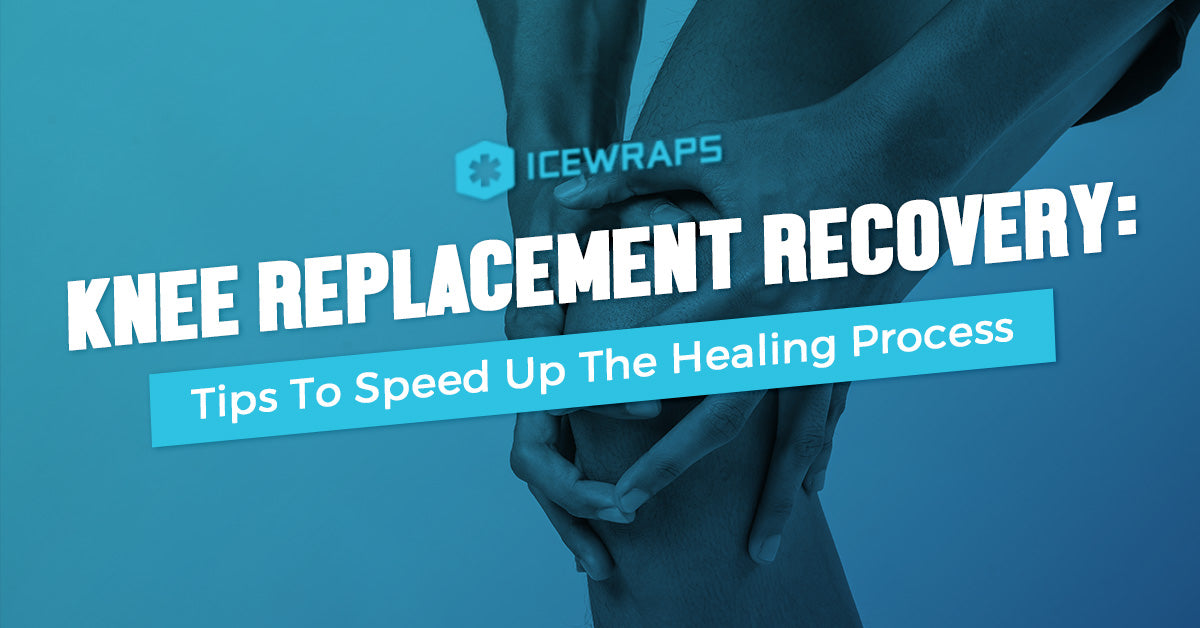Your Cart is Empty

Contents
So you just got yourself a brand-new knee. Congrats, you're on your way to a relatively pain-free life!
But before you bust your moves on Salsa Night or go up a flight of stairs (look, Gina, no walker!), you should first ensure a full recovery.
Getting a new metal knee isn't a walk in the park, and your knee replacement recovery journey may be full of challenges, so here are some tips to help speed up the healing process:
Before we dive straight into wound care and the various therapies and exercises that come after a knee replacement surgery, it's important to set the right expectations.
A knee replacement surgery (otherwise known as arthroplasty) is a major surgical procedure that involves the removal of the damaged bones and cartilage that make up your knee joint. Once these parts are removed, metal and plastic components are inserted in their place.
The surgery has two variations: total knee replacement, where the entire knee joint is replaced, and partial knee replacement, where only a single component of the knee joint is fixed. In this article, we’ll be talking mostly about total knee replacement, since it’s more commonly done.
The surgery can last up to two hours long and the patient can stay in the hospital for two to five days.
While 97% of total knee replacement surgeries are successful, the road to recovery is quite long. Prognosis also depends on the individual's age, weight, and general health status prior to the surgery. Studies show that people who are healthier and are active prior to surgery recover much faster than people who aren’t. A pre-operative consultation with your primary healthcare provider and surgeon will give you a general idea of how long your recovery time will be.
Most patients find themselves able to do normal activities like getting up and walking around the house after a couple of weeks, however, full recovery can take about 6 months to a full year.
Here's the typical recovery timeline for post-op patients:
Post-op pain is one of the most common things you'd notice some hours after surgery, especially when the local anesthetic has worn off. Your doctor usually prescribes low doses of opioid painkillers like morphine or oxycodone immediately after the surgery to help manage the worst of the pain. Afterward, you'll be prescribed oral analgesics and pain relievers for around 6-12 weeks.
It's important for you to take meds as prescribed to prevent dependence, pain flare-ups, and complications.
Now, while medication plays an important part in pain management, there are non-pharmacological ways to ease discomfort, like cold therapy.
Cold therapy is a great way to reduce pain and swelling around your knee. Cold temperature constricts your blood vessels and lessens inflammation. It also helps soothe nerves around the wounded area. To help with post-op pain, apply a cold pack around the wound, three times a day for about 10-15 minutes at a time. Be careful not to apply the cold pack directly to your skin though! Use a cloth cover to prevent ice burns and skin damage and to protect the incision from getting wet.
 |
| ICEWRAPS 10X14 STANDARD COLD THERAPY CLAY PACK WITH COVER |
 |
Icewraps' reusable cold therapy packs come in all shapes and sizes. They're guaranteed to stay cold for a long period of time but will remain pliant for you to ice those hard-to-reach areas.
Once your wound has healed, you can use a cold therapy compression wrap like ActiveWrap or Pro Ice to manage swelling and help speed up recovery. Compression wraps combine the therapeutic benefits of cold therapy with compression, allowing the cold temperature to be delivered consistently throughout the limb. Self-fasteners secure these therapy wraps in place, so you can still move around without a hitch.
Other ways to alleviate pain include elevation of the site, and using topical pain-relief creams and ointments. Relaxation techniques like proper breathing exercises, soft music, guided imagery, and aromatherapy are also helpful in creating a calm, stress-free environment to help you manage pain.
You must also know how to look out for signs of infection like the following:
If you see these signs and symptoms, call your doctor immediately.
It's important to regain mobility as soon as possible to prevent muscle weakness and excessive scar tissue formation.
You're encouraged to move around immediately after surgery. Standing and ambulation with the help of a walker, crutch or cane are expected within 24 hours. Now, using these devices can be quite challenging, but don't worry, your physical therapist will teach you how to use them properly. You can also check out tutorials like the one above to learn more about using assistive devices.
You might also have to use a continuous passive motion device or CPM while recovering from the surgery. This machine gently stretches and flexes your knee to prevent stiffness and complications, helping you regain mobility faster. You can also place a rolled-up towel under your ankle to keep your operated knee straight while at rest.
Your medical team and physical therapist will also assist you in doing activities of daily living like getting up from bed, sitting up, using a commode or the bathroom, walking around, and dressing until you're able to do them by yourself with minimal help.
Brace yourself, the next three months following your surgery will be full of physical therapy visits and exercises. You might feel some pain at first, but discomfort is necessary to help you regain muscle strength, mobility, and range of motion. It will gradually decrease once your incision heals and once you adjust to your new knee.
As mentioned earlier, physical therapy will begin immediately after surgery. You'll receive inpatient therapy from your physical therapist, which involves stretches, exercises to help you with daily activities, walking with assistive devices, using a CPM, and slowly climbing up a few steps.
After a few days in the hospital, you may be discharged and allowed to go home or to a rehab care facility. Your physical therapist will develop a plan of care that will specifically cater to your individual needs.
Walking is highly recommended; you'll often be required to walk around for 30 minutes 3 times a day to help strengthen your muscles, regain balance, and prevent the excessive formation of scar tissue.
Other exercises that you can do early in the recovery phase include leg lifts, which involve lying in bed and lifting your straightened leg.
Quad sets are also great for strengthening your quadriceps muscles. To do quad sets, make sure that your leg lies flat in bed and tighten and relax your thigh muscles.
You will be required to do ankle pumps, too, wherein you flex and extend your ankle joint while lying down.
Later on, you'll be able to do more exercises while sitting down on a chair or standing up with a walker. Check out the video above to learn the usual exercises recommended after a knee replacement surgery.
Recovering from knee replacement surgery may be tough, but it's the first step to living a new life away from pain and discomfort. The only way out is through, so hang in there! With the proper treatment regimen, the right attitude, and a strong support system, you'll be ready to walk around in those new knees in no time.
Have you recently had knee replacement surgery? Which stage of recovery was the hardest? Let us know your thoughts by leaving a comment below!
Comments will be approved before showing up.